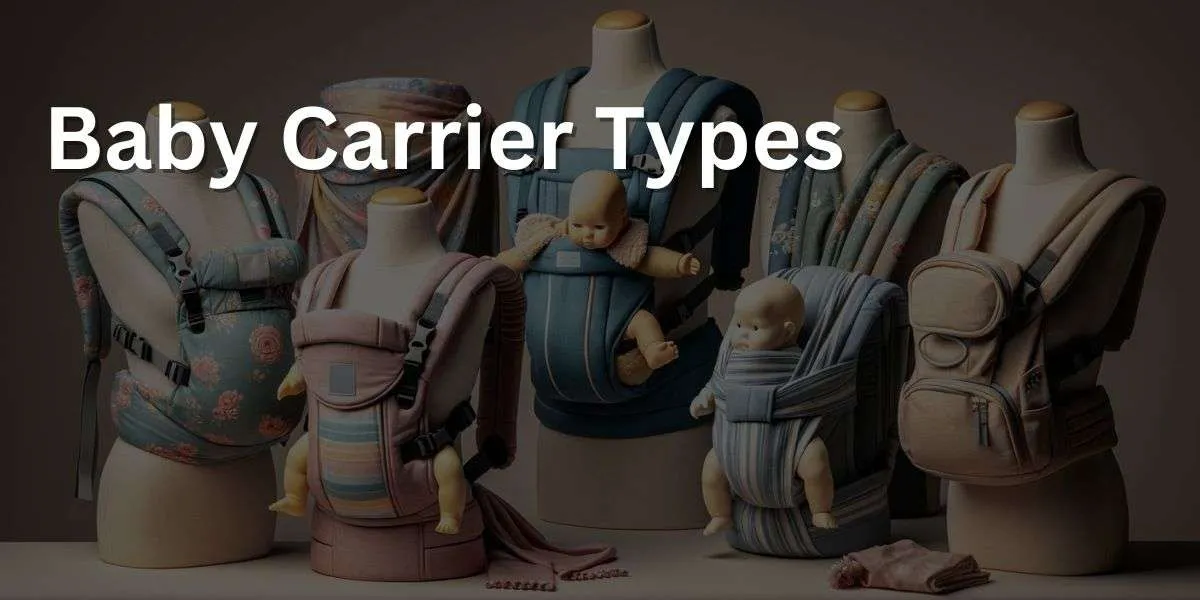Hello, I’m Maebh Collins, a seasoned baby carrier consultant with over two decades of experience. As a certified expert in both Trageschule and Slingababy, I’ve had the privilege of assisting thousands of families in their journey to find the perfect baby carrier. Welcome to a world of comfortable, confident babywearing!
Navigating the world of baby carrier types can be daunting for new parents.
With various styles and designs available, each offering unique benefits, understanding the differences is key to finding the perfect match for your family.
Whether you’re looking for something for occasional use or a carrier for daily wear, understanding these types will help you make an informed choice about choosing a baby carrier for you that ensures comfort and safety for both you and your baby.
Key Takeaways: Types of Baby Carriers
- Baby Wrap carriers are a versatile and snug option. Baby wraps consist of a long piece of fabric you wrap around your body, ideal for newborns due to their closeness and flexibility.
- Structured carriers offer ergonomic support. Often called a buckle carrier these have padded straps and waistbands, providing good support for both the baby and the wearer, suitable for older babies and you often get a toddler carrier version.
- Ring slings are easy to use and adjustable. A length of fabric and two rings make up this carrier, allowing quick adjustments and a good fit for infants through toddlers.
- Mei Tai carriers combine structure and flexibility. They have a more structured body than wraps but are tied like slings, offering a balance of support and adaptability.
- Pouch slings are simple but less adjustable. A pouch sling is a loop of fabric, offering a quick and easy option for carrying, though they don’t offer as much adjustability.
- Backpack carriers are ideal for older babies and toddlers. Resembling hiking backpacks, they’re great for long walks and outdoor activities with kids who can sit unassisted.
- Hip seat carriers focus on hip positioning. They provide a seat for the baby to help distribute their weight more evenly, suitable for short periods of carrying.
- Choose based on baby’s age, your lifestyle, and comfort. Different types cater to different needs, like newborn closeness, toddler mobility, or parent comfort during longer wear.
- Safety and ergonomic support are paramount. Ensure the carrier supports the baby’s hips and back correctly and is comfortable for the wearer.
- Try different types to find the best fit. What works well for one family might not suit another, so personal preference is key.
Types of Baby Carriers
Front Carriers: These carriers allow you to wear your baby on your chest, facing either inward or outward. They’re ideal for newborns and younger infants, providing the closeness and bonding that both you and your baby need. Front carriers typically have adjustable straps and buckles, making them easy to secure and adjust for a comfortable fit.
- Pros: Great for bonding, suitable for newborns and small infants
- Cons: Can be uncomfortable for extended periods, not ideal for larger babies
Hip Carriers: As your baby grows and becomes more curious about the world, a hip carrier can be a wonderful option. These carriers position your baby on your hip, allowing them to see what’s going on while still being close to you. They’re usually made with soft, adjustable fabric and can be a good transition carrier for older infants and toddlers.
- Pros: Good for curious babies, comfortable for parent and child
- Cons: Not suitable for newborns, can cause strain on one shoulder
Backpack Carriers: When you’re ready to start venturing out for longer walks or hikes with your little one, a backpack carrier is an excellent choice. These carriers are designed for older babies and toddlers, offering support and comfort for both of you during outdoor adventures. With a sturdy frame and padded straps, they evenly distribute weight across your back and shoulders.
- Pros: Ideal for long walks and hikes, comfortable for extended periods
- Cons: Not suitable for newborns, can be bulky and difficult to store
Soft Structured Carriers (SSCs): These versatile buckle carriers offer the best of both worlds, combining the convenience of a front carrier with the support of a backpack carrier. They can be worn on your front, back, or hip, making them perfect for parents who want one carrier to suit all their babywearing needs. SSCs have padded shoulder straps and waistbands, ensuring comfort and support.
- Pros: Highly versatile, suitable for newborns to toddlers, comfortable
- Cons: Can be expensive, may require additional accessories for newborns
ring slings: Perfect for those who prefer a more natural, minimalistic carrier, ring slings are made from a single piece of fabric threaded through two rings. Easily customizable to your size and your baby’s position, ring slings are lightweight and easy to use. They can be worn on your front or hip, making them perfect for everything from quick trips to the store to extended babywearing sessions.
- Pros: Lightweight, simple design, suitable for newborns to toddlers
- Cons: May take practice to learn proper positioning, potential strain on one shoulder
Now that you’re familiar with the different types of baby carriers, you can choose the option that best fits your lifestyle and comfort preferences. Happy babywearing!
Stretchy Wrap
The stretchy wrap is a fantastic option for new parents who want a comfortable and versatile baby carrier. Made from soft, stretchy fabrics like cotton or bamboo, a stretchy wrap can adapt to your baby’s shape and size, providing a cozy and secure carrying option.
One of the main benefits of using a stretchy wrap is its incredible flexibility. With just one long piece of fabric, you’re able to create numerous carrying positions to suit your needs. Some popular carrying positions include the:
- Front-carry, inward-facing
- Front-carry, outward-facing
- Hip carry
Stretchy wraps can be easily adjusted to accommodate your growing child, though honestly I don’t recommend them after 5-6 months. As your little one gets bigger, you can tie the fabric in different ways, ensuring that you both stay comfortable and secure.
Woven Wraps
Woven wraps are a versatile and comfortable option for carrying your baby. They are made from a long piece of woven fabric, typically ranging from 2 to 6 meters in length, depending on your size and wrapping preferences.
There are many benefits to using a woven wrap:
- Versatility: You can use a woven wrap for a variety of carrying positions, such as front, hip, and back carries. It is suitable for newborns, infants, and toddlers.
- Customizable: With a woven wrap, you can adjust the fabric to fit you and your baby’s body perfectly, providing optimal support and comfort.
- Even weight distribution: The wrap helps distribute your baby’s weight evenly across your back and shoulders, making it comfortable to wear for extended periods.
When choosing a woven wrap, there are several factors to consider:
- Material: Woven wraps come in various materials, including cotton, linen, bamboo, and blends. Each material offers different qualities, such as breathability, stretch, and support. Consider your climate and personal preferences when selecting a material.
- Size: The size of the wrap will determine the type of carries you can do. Longer wraps are more versatile but can be more challenging to manage for beginners. A size 5 (4.2 meters) or 6 (4.6 meters) wrap is a good starting point for most people.
- Design: There is a wide range of colors, patterns, and styles available in woven wraps. Choose one that speaks to your personality and will make you feel happy and confident while wearing it.
Ring Slings
Ring slings are a popular option for babywearing, offering versatility and comfort for both you and your little one. In this section, we’ll explore the basics of ring slings, as well as some advantages and potential drawbacks.
A ring sling is essentially a long piece of fabric with two rings at one end. To use it, you thread the fabric through the rings and secure it in place, creating a comfortable pouch for your baby. You can wear a ring sling on either your front, hip, or back, making it a versatile choice for parents.
Some benefits of using a ring sling include:
- Quick and easy to put on: With practice, you’ll be able to put on a ring sling in a matter of seconds.
- Adjustable fit: Since you control the tightness, you can easily adjust the sling to your body and your baby’s size.
- Breastfeeding-friendly: The adjustable nature of the ring sling also makes it easier for breastfeeding on the go.
- Less bulky: Unlike some other carrier types, a ring sling can be easily folded and tucked into a diaper bag when not in use.
However, there are also some drawbacks to consider:
- Uneven weight distribution: Since a ring sling is worn on one shoulder, it can cause discomfort or strain over time, especially with heavier babies.
- Learning curve: It may take some practice to learn how to properly thread and adjust a ring sling for a secure fit.
When selecting a ring sling, look for the following features:
- Fabric: Choose a sling made of breathable, sturdy material, such as cotton or linen.
- Rings: Opt for sling rings made of aluminum or high-quality plastic, as they are strong and less likely to slip.
- Size: Ensure the length of the sling is appropriate for your body size, as well as your baby’s.
- Padding: Some ring slings come with padded rails or shoulder padding for added comfort.
Soft Structured Carriers
Soft structured carriers (SSCs) are a popular choice for many parents due to their ease of use and versatility. They give you the opportunity to hold your little one close in a variety of positions and usually come with padded shoulder straps and a waistband for maximum comfort and support.
There are several key features to look for when choosing a soft structured carrier:
- Wide, padded shoulder straps: These help distribute your baby’s weight evenly across your shoulders. Look for straps that can be easily adjusted to fit your body.
- Adjustable waistband: This will provide additional support and help distribute the baby’s weight across your hips, making the carrier more comfortable to wear for longer periods.
- Easy-to-use buckles or latches: You want it to be as easy as possible to get your baby in and out of the carrier, especially when they’re fussy.
- Breathable fabric: Choose materials that are lightweight and breathable to help regulate your baby’s temperature and ensure they don’t overheat.
As your baby grows, you may want to try different carrying positions to find the most comfortable fit for both you and your little one.
Here are some common carrying positions in SSCs:
- Front inward-facing: Suitable for newborns and younger babies, this position keeps your baby close to your chest and provides sufficient head support.
- Front outward-facing: This position is suitable for babies who can hold their head up independently, usually around 4-6 months old. It allows your baby to explore their surroundings while still being safely supported by the carrier.
- Hip carry: Ideal for babies who can sit up independently, this position allows you to carry your baby on your hip, giving them a better view of the world.
- Back carry: This position is recommended for older babies and toddlers, as it provides the best support for your back. It allows your child to see over your shoulder, giving them a more panoramic view of the world around them.
Popular brands include Lillebaby, Ergobaby, Babybjorn and Infantino.
Meh Dai
A Meh Dai and other asian style carriers are traditional Chinese baby carrier is a great option for comfortable and versatile babywearing.
The Meh Dai consists of a square or rectangular cloth panel with straps attached to each corner. Two of the straps are used for tying around your waist, and the other two go over your shoulders. The straps can be tied in various ways, making it adaptable to different body types and baby sizes.
Some common materials used for Meh Dai carriers include cotton, linen, and silk.
There are several benefits to using a Meh Dai carrier:
- Customizable fit: Since you tie the straps, you can achieve a comfortable fit for both you and your baby.
- Even weight distribution: The straps cross over your shoulders and back, helping to distribute your baby’s weight evenly.
- Suitable for newborns to toddlers: As your baby grows, you can adjust the carrier to accommodate changes in size and weight.
- Versatility: Meh Dai carriers can be used for both front and back carrying positions.
- Easy to share: Since the straps are adjustable, it can be easily shared between caregivers without the need for other carriers.
Hip Seat
Hip seat carriers are quite popular among new parents for their versatility and convenience. With this carrier, you essentially get two styles in one: a hip seat for older babies and toddlers and an integrated full carrier for infants. Let’s have a look at some features of a hip seat carrier:
- Sturdy, non-slip seat: The base of the carrier has a built-in seat for your baby, making it easy to carry them in a variety of positions. Rest assured, because the seat is designed to be non-slip, providing a secure grip for your little one.
- Ergonomic support: The hip seat distributes your baby’s weight evenly across your waist and hips, reducing strain on your back and shoulders. It’s designed to encourage better posture and maintain the ideal “M-shape” position for your baby’s legs, promoting healthy development of their hips.
- Multiple carrying positions: One of the best aspects of the hip seat carrier is its versatility. You can carry your baby facing inwards, outwards, on your back, or simply on your hip as they grow older. This makes it suitable for different stages of your baby’s development.
- Adjustable and comfortable: The carrier is easily adjustable, ensuring it fits both you and your baby comfortably. With padded straps, extra support for your lower back, and breathable fabric, you’ll likely find it comfortable to use for longer periods.
- Your child needs full neck control to be able to use a hip seat, so they are better for an older baby.
Frame Backpack Carrier
A frame backpack carrier is an excellent choice for parents who love the outdoors and want to share their adventures with their little ones. These carriers are designed to provide comfort and stability during long walks or hikes.
The frame backpack carrier typically consists of a sturdy, lightweight external frame, padded shoulder straps, and a waist belt for support. The child sits in a soft, structured seat that is attached to the frame. This setup allows for optimal weight distribution and stability while keeping your baby secure and comfortable.
There are a few key features to look for when choosing a frame backpack carrier:
- Weight capacity: Ensure the carrier can support the weight of your child as they grow. Most backpack carriers accommodate children between 15-50 pounds.
- Adjustable straps: Look for adjustable straps, both for your own comfort and to ensure a proper fit as your child grows.
- Sunshade: A sunshade is essential to protect your baby’s delicate skin from the sun’s harmful rays during outdoor adventures.
- Storage: Since you’ll be carrying diapers, snacks, and extra clothing, make sure the carrier has ample pockets and compartments for everything you need.
Baby Carriers for Twins
If you have twins, finding the right carrier enables you to maintain a close bond with both babies while freeing up your hands. The best baby carrier for twins should provide the following features:
- Multiple carrying positions: Look for carriers that allow you to carry both babies simultaneously in various positions, such as one in front and one in back, or both on your hips.
- Adjustable weight distribution: A carrier that enables you to distribute the weight of your babies evenly will help reduce strain on your body and ensure their comfort.
- Age and size accommodations: Make sure the carrier is suitable for your babies’ age and size, as some carriers are designed specifically for newborns while others can handle larger or older infants.
A popular choice for parents of twins is the tandem baby carrier, which allows you to carry both babies in one carrier. These carriers are designed with multiple pockets, straps, and buckles to secure your babies safely and comfortably. They often come with removable inserts for customized support as your children grow.
Baby Carrier Types FAQs
Are baby carriers safe for newborns?
The short answer to this question is yes. Although it’s important to make sure the baby carrier you have is suitable for the size and weight of your baby. Some carriers will require a newborn insert for example if you wish to carry from birth. Just make sure your baby’s airway isn’t being restricted.
Is a forward facing carrier bad for baby?
Providing your baby has good head control, usually around 6 months plus, and your baby carrier keeps their hips in a healthy position then forward facing baby carrying is fine for short periods of time. Just be aware that babies can easily become over stimulated by new surroundings so switch them back to face you if they begin to fuss or if they are getting tired.
Are baby carriers bad for babies hips?
A good ergonomic baby carrier is perfectly safe for babies hips and in fact will keep babies hips in the same position used if hip dysplasia were to be diagnosed. However carriers that leave legs dangling and have all the weight on the groin are not optimal for hip development.
Is it safe to wear a baby carrier while pregnant?
Yes. The good news is that babywearing is safe while you’re pregnant, providing of course that you haven’t been given any medical advice against physical activity. Just make sure you choose the most comfortable carrying position and listen to your body. As your bump grows you will probably be more comfortable back carrying. And be considerate to the fact that you will tire more quickly when pregnant.





